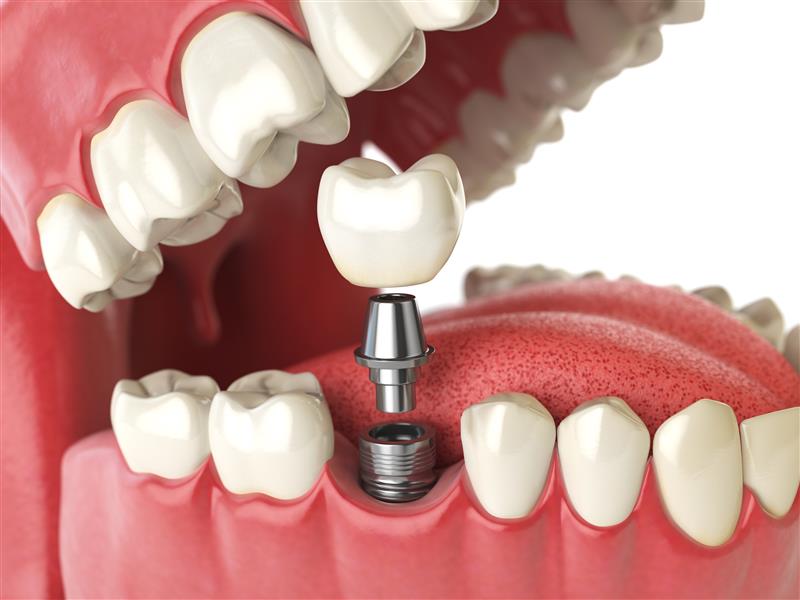 A dental implant can be a great treatment option to replace a missing tooth. While the first dental implant was placed over 50 years ago, recent advances in dentistry and implantology have made this a predictable and successful treatment. Most modern dental implants are made from titanium, an extremely durable and biocompatible material. A dental implant is placed into the bone and then acts like a scaffold to hold a dental crown or cap. Unlike a dental bridge, under normal circumstances, none of the teeth near an implant need to be prepared in order to place an implant. Implants can also last a very long time. Implants have proven to be one of the most revolutionary inventions in all of dentistry.
A dental implant can be a great treatment option to replace a missing tooth. While the first dental implant was placed over 50 years ago, recent advances in dentistry and implantology have made this a predictable and successful treatment. Most modern dental implants are made from titanium, an extremely durable and biocompatible material. A dental implant is placed into the bone and then acts like a scaffold to hold a dental crown or cap. Unlike a dental bridge, under normal circumstances, none of the teeth near an implant need to be prepared in order to place an implant. Implants can also last a very long time. Implants have proven to be one of the most revolutionary inventions in all of dentistry.
Who can get a dental implant?
Dental implants can be used to replace one missing tooth or multiple missing teeth. In fact, even patients with dentures could be great candidates to get multiple implants. Implants can be used as a base for the denture to snap into place. Implant-supported dentures can help prevent ill-fitting dentures and can even help improve your ability to chew and function. Dental implants can truly be life-changing in this regard!
What steps are involved in getting a dental implant?
For most doctors, the dental implant process starts before a bad tooth gets removed. The doctors will assess the situation, take out the tooth, and place a bone graft into the extraction site to help regrow more bone in that area, in hopes of placing an implant there in the future. If you already have an area with a missing tooth, the first step in the process is to get a cone beam X-ray taken. A cone-beam X-ray creates a 3-D image of your bone and allows the doctor to determine if you have enough bone to place an implant. If you do, the doctor will then likely take an impression of your teeth to help make a surgical guide.
 The recent improved success and longevity of dental implants owe a lot of credit to the progression of digital dentistry. With today’s technology, a cone beam X-ray and an impression of your teeth can allow us to make an extremely accurate surgical guide. This allows the doctor to do all of the implant planning prior to your surgery. By the day of surgery, we will already have a guide that tells us exactly where to put the dental implant. This allows for much more precision, better healing, and longer-lasting implants.
The recent improved success and longevity of dental implants owe a lot of credit to the progression of digital dentistry. With today’s technology, a cone beam X-ray and an impression of your teeth can allow us to make an extremely accurate surgical guide. This allows the doctor to do all of the implant planning prior to your surgery. By the day of surgery, we will already have a guide that tells us exactly where to put the dental implant. This allows for much more precision, better healing, and longer-lasting implants.
The next appointment is surgery day. While it may sound like an ominous term, most people report dental implant surgery and recovery to be relatively painless! After the implant is placed, you will have to wait 3-4 months until a crown can be put on the implant. The reasoning for this is that the 3-4 month timeframe allows for the bone to grow in around the implant, and gives it even more stability. If we put a crown on a dental implant immediately, we risk the chance of putting too much force on the implant and having it fail. Waiting 3-4 months after implant surgery to get your crown allows for the best possible success of the implant. Once the crown is placed into the implant, the doctor will continue to X-ray and monitor this at most of your follow-up hygiene visits.
